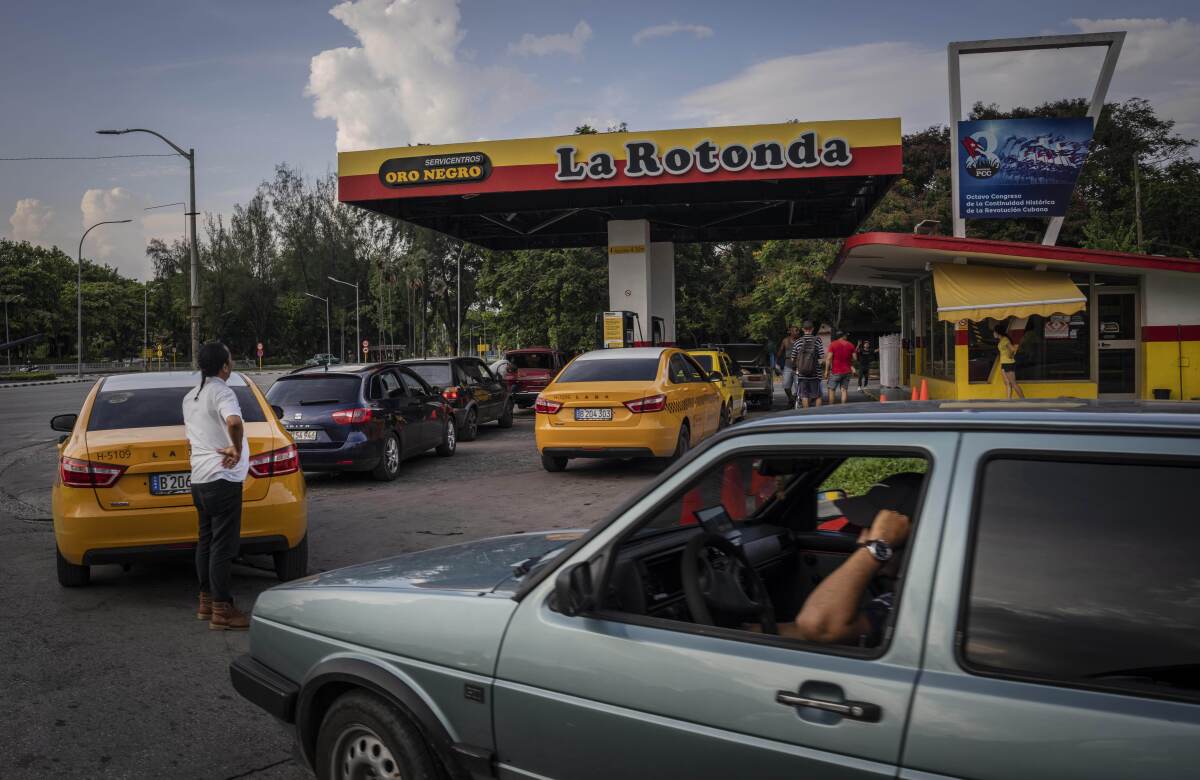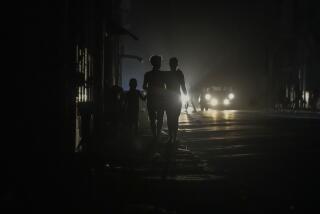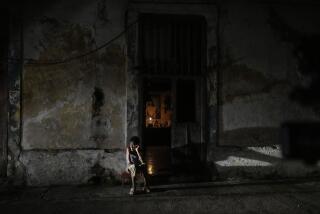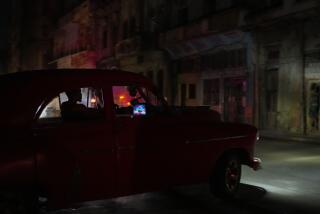Cuban drivers endure long lines to fill up as diesel fuel is diverted to power plants

- Share via
HAVANA — Dany Pérez had spent four days in a line of vehicles waiting to fill his truck with the diesel fuel he needs for the 560-mile trip from Havana to his home in eastern Cuba.
Taxi driver Jhojan Rodríguez had been waiting at another station even longer — it was nearing two weeks — but he was finally near the head of the line of hundreds of vehicles in the Playa district of the capital.
Such lines have become increasingly common in Cuba, where officials apparently have been sending the island’s scarce diesel fuel to power generation plants rather than filling stations for vehicles.
It’s not the first time the island has suffered fuel shortages, but it’s one of the worst.
“I have seen pretty bad situations, but not like now,” said the 46-year-old Pérez, who was eating and sleeping in his 1950s-era Chevrolet truck, which he has outfitted as a bus with room for some 40 passengers.
Republican primaries this year have revealed a new political strategy for numerous candidates.
Drivers in the lines have tried to organize themselves by creating lists of those waiting and updating them daily as they wait for tanker trucks to arrive with fuel. Because of the lists, those who live nearby can go home for spells — keeping track of any progress via a WhatsApp message.
“I’m a professional taxi driver. I pay taxes, social security. I’m legally established,” said Rodríguez, the 37-year-old owner of a gold-and-white 1954 Oldsmobile, refitted with a diesel engine years ago when its gas engine wore out. “My home, my family depend on this diesel.”
The car had run out of fuel and Rodríguez had to push it into the line. That was 12 days earlier. Authorities say drivers can only fill their tanks, not other containers. For Rodríguez, that’s 16 gallons, which he said will last him three days.
The recent fuel shortage largely affects diesel — used by heavy vehicles and classic cars whose original engines were long ago swapped out, often with Eastern European truck engines — rather than the gasoline used by most of the world’s cars.
Rodriguez expressed frustration at the lack of clear explanations from officials.
“Nobody has said, ‘This is what is happening’ with the fuel,” Rodríguez said. “If at some point there was information that, ´Look, there is no fuel because the situation of the country requires it to give electricity to people,’ I would understand.”
Experts — agreeing with the scuttlebutt in the streets — say the country can’t afford to buy all the diesel it needs and what it has is being directed to generate power.
“What we are seeing is what we call the domino effect,” said Jorge Piñon, director of the Latin America and Caribbean Energy Program at the University of Texas at Austin.
“The collapse of the thermoelectric plants has caused an increased demand for diesel generation groups. Venezuela has not been sending Cuba the quantity of diesel it needs, so Cuba has had to take part of the supply that was dedicated to the transport sector for the diesel electric generation groups,” he said.
Half of Cuba’s power comes from 13 thermoelectric plants, which burn fuel to produce steam that drives turbines that generate electricity. Eight of the plants are more than 30 years old. They usually depend on the island’s own heavy crude oil, but their operation has been erratic. So the island turns to diesel units to try to cover the shortfall.
Before the COVID-19 pandemic, Cuba used about 137,000 barrels a day of fuel — gasoline, diesel, natural gas and derivatives — to keep the economy moving. About half of that came from political ally Venezuela, which itself has sunk into economic crisis and, under mismanagement and U.S. embargoes, has found it increasingly difficult to produce and ship fuel.
A series of recent power blackouts caused public grumbling and led Cuban President Miguel Díaz-Canel to try to explain the situation on national television and tour thermoelectric plants.
International news media and tanker tracking sites reported that a Russian tanker carrying 700,000 barrels of oil reached Cuba in recent days, though authorities did not comment.
“We think it’s a shipment from Russia in place of Venezuela — that it is a triangulation where Russia is substituting for Venezuela with this shipment, later to be paid by Venezuela and not by Cuba,” Piñon said.
Meanwhile, Cubans are adapting as they can — whether by sticking it out at home or by making plans to head abroad.
“I am going to keep struggling because I can’t stop working,” Pérez said at the station in Guanabacoa, east of central Havana. “but if there’s no [fuel], we will have to park it.”
At the station in Playa, the taxi driver Rodríguez said he was thinking of other options.
“My Plan B is to sell the car and leave the country with my family,” he said. “I don’t know what I am going to do.”
More to Read
Sign up for Essential California
The most important California stories and recommendations in your inbox every morning.
You may occasionally receive promotional content from the Los Angeles Times.











